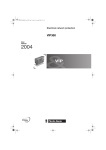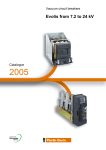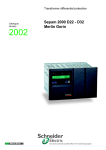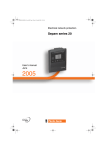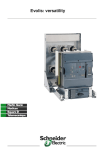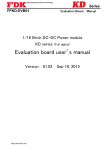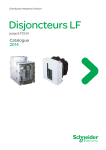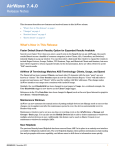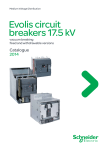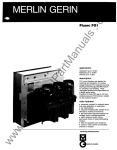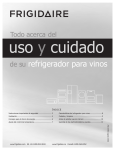Download VIP30, VIP35
Transcript
Electrical network protection VIP30, VIP35 User’s manual 12/2008 Safety instructions Safety symbols and messages Read these instructions carefully and look at the equipment to become familiar with the device before trying to install, operate, service or maintain it. The following special messages may appear throughout this bulletin or on the equipment to warn of potential hazards or to call attention to information that clarifies or simplifies a procedure. Risk of electric shock The addition of either symbol to a “Danger” or “Warning” safety label on a device indicates that an electrical hazard exists, which will result in death or personal injury if the instructions are not followed. ANSI symbol. IEC symbol. Safety alert This is the safety alert symbol. It is used to alert you to potential personal injury hazards and prompt you to consult the manual. Obey all safety instructions that follow this symbol in the manual to avoid possible injury or death. Safety messages DANGER DANGER indicates an imminently hazardous situation which, if not avoided, will result in death, serious injury or property damage. WARNING WARNING indicates a potentially hazardous situation which, if not avoided, could result in death, serious injury or property damage. CAUTION CAUTION indicates a potentially hazardous situation which, if not avoided, could result in minor or moderate injury or property damage. Important notes Restricted liability Electrical equipment should be serviced and maintained only by qualified personnel. No responsibility is assumed by Schneider Electric for any consequences arising out of the use of this manual. This document is not intended as an instruction manual for untrained persons. Device operation The user is responsible for checking that the rated characteristics of the device are suitable for its application. The user is responsible for reading and following the device’s operating and installation instructions before attempting to commission or maintain it. Failure to follow these instructions can affect device operation and constitute a hazard for people and property. Protective grounding The user is responsible for compliance with all the existing international and national electrical codes concerning protective grounding of any device. PCRED399007EN - 12/2008 Contents PCRED399007EN - 12/2008 Functions and characteristics 4 Presentation of VIP30 and VIP35 relays 4 Presentation of CRc and CEc sensors 5 Description of VIP30 and VIP35 relays 6 Presentation of the VAP6 test unit 8 Using the VAP6 test unit 9 Technical characteristics 10 Installation and connection 12 Mounting 12 Connection 14 3 1 Functions and characteristics Presentation of VIP30 and VIP35 relays DE50894 Self-powered protection relays 2 Simplified wiring diagram. VIP30 and VIP35 relays are designed for use in power distribution systems, mainly in MV/LV substations where they provide protection upstream from the transformer. They are self-powered relays (supplied by current sensors) requiring no auxiliary power supply. They actuate a Mitop release. b The VIP30 provides protection against phase-to-phase faults. b The VIP30 WED has the same characteristics as the VIP30. The only difference concerns the markings on the setting label. The VIP30 WED settings depend on the power rating. b The VIP35 provides protection against phase-to-phase and earth faults. Phase protection DE10326 Phase protection uses an IDMT set point equal to 1.2 times the current setting (Is). The VIP30 and VIP35 phase protection functions are the same. VIP30 and VIP35 phase protection. Earth fault protection DE50896 Earth fault protection is based on residual current measurements using the sum of the sensor secondary currents. Measurements are carried out by a CSH30 core balance CT mounted on the back of the VIP35 unit. Earth fault protection operates according to definite time characteristics; the set point and time delay are adjustable. VIP35 earth fault protection. Equipment description The VIP30 and VIP35 relays are mounted in an injected polycarbonate casing that protects them against dripping water and dusty environments. The front is protected by a transparent cover fitted with a sealing gasket. The cover may be lead-sealed to protect access to the settings. Rotary selector switches are used for settings. The phase and earth fault current settings are made directly in amperes. This means that the graduations on the front must be adapted to suit the sensor range used. This is done by fitting the appropriate setting label when mounting the relay. The connection is made on the back of the relay using fast-on type connectors. 4 PCRED399007EN - 12/2008 Presentation of CRc and CEc sensors Functions and characteristics To obtain the indicated performance characteristics, VIP30 and VIP35 relays must be used with the specified sensors. The relay/sensor assemblies are defined to respect the technical characteristics indicated, in particular: b operation over the entire range b tripping time b accuracy b short-circuit thermal withstand. The same type of sensor must be used on each phase. 2 DE50902 CRc and CEc sensors for VIP30/VIP35: CRc 200/500/1 sensors are used on RM6 units (models since 1998). CEc 200/500/1 sensors are used on 24 kV Evolis integrated circuit breakers. CRc and CEc sensors have two secondary windings. The wiring of the sensor secondary windings determines the VIP30/VIP35 current setting range. Ratio Wiring 8A - 80 A Current setting range 200 / 1 S1 - S2 20A - 200A 500 / 1 S1 - S3 The cross-section of the core and the resistance of the winding are chosen so as to protect the VIP30/VIP35 in the event of a high fault current and/or a short-circuit on the MV system. PCRED399007EN - 12/2008 5 Description of VIP30 and VIP35 relays DE80359 Functions and characteristics VIP 30 2 VIP30 front panel. VIP30/VIP35 phase protection DE50899 b 1: phase protection zone Information concerning phase protection is presented in the dark zone at the top of the front panel. This zone is the same for the VIP30 and VIP35. b 2: current setting Is Time-delayed tripping of the phase protection takes place at 1.2 x Is. Depending on how the sensors are wired, the current setting is adjustable from 8A to 80A or from 20A to 200A; the selector switch graduations are adapted to the range by fitting the appropriate setting label. Other VIP30/VIP35 functions b a: setting label The setting label should be fitted on the VIP30/VIP35 when it is mounted on the circuit breaker. The label indicates the graduations of the phase current setting (VIP30/VIP35) and earth protection setting (VIP35) selector switches. It is inserted, from the top, behind the transparent part of the front panel. How to fit the setting label. b b: sensors used and wiring The text is printed on the setting label. It indicates the secondary winding of the CRc or CEc sensors used to give the desired setting range. When the label is in position in the slot, the text is hidden by a non-transparent zone. It is not visible to the user. DE50917 b c: VAP6 test plug The test plug is exclusively designed for connection of the VAP6, used for fast and easy relay testing. The test may be carried out during normal operation of the installation since the VAP6 and VIP30/VIP35 provide the possibility of testing without circuit breaker tripping. The test is possible even if the relay is not supplied by the sensors. In that case, the VAP6 supplies the VIP30/VIP35. Testing the VIP30/VIP35 with the VAP6. 6 b d: minimum time delay switch The circular opening on the front face provides access to a switch used to delay the tripping order by at least 25 ms. The time delay may be enabled to prevent the circuit breaker from breaking at the beginning of the asymmetrical phase in the event of a high fault. It should be enabled or disabled depending on the type of circuit breaker. The user does not have access to the time delay switch since the opening is hidden by the setting label. PCRED399007EN - 12/2008 Description of VIP30 and VIP35 relays DE80360 Functions and characteristics VIP 35 2 VIP35 front panel. VIP35 earth protection b 4: earth protection zone This zone contains the earth protection settings. b 5: earth protection setting The setting is made directly in MV amperes. b 6: earth protection time delay The earth protection time delay is set in seconds. When the circuit breaker closes, energizing of the MV/LV transformer may generate aperiodic inrush currents with a DC component that momentarily saturates the magnetic cores of the VIP35 sensors. Consequently, each sensor gives an erroneous result and the sum of the phase currents (at the sensor secondary windings) is no longer zero. This gives rise to a false earth fault detection and can cause unnecessary tripping of the earth protection. This is especially critical for low earth protection current and time-delay settings. If the earth protection time-delay setting is below the value indicated in the table below for the current setting used, the inrush current delay time delay should be enabled. Io> setting to> time delay 0.8 to 0.9 x Ia 0.2 s 0.6 to 0.8 x Ia 0.3 s 0.4 to 0.6 x Ia 0.4 s 0.2 to 0.4 x Ia 0.5 s b 7: inrush current delay This selector switch is used to enable the inrush current delay (1s). The time delay prevents the earth protection from tripping when the VIP35 is energized upon circuit breaker closing. The time delay only applies to the earth protection and has no effect on tripping by the phase protection. In "off" position, the inrush current delay is disabled. The earth protection operates according to the delay set on the selector switch (6). In "on" position, the inrush current delay is enabled. In this case: v when the VIP35 is energized, and the circuit breaker is closed, tripping by the earth protection is delayed by 1 second v when the VIP35 has been supplied for more than a second, the earth protection is delayed according to the setting (6). Ia: rated current of the transformer to be protected. PCRED399007EN - 12/2008 7 Presentation of the VAP6 test unit Functions and characteristics DE80361 The VAP6 is a portable unit that can be connected to the VIP30/35 to carry out simplified testing. The test can be carried out in the following two cases: b the VIP30/VIP35 is already supplied by the sensors b the VIP30/VIP35 is not supplied; in this case the VAP6 batteries supply power to the relay. The test consists of: b injecting a stimulus to simulate a phase fault b injecting a stimulus to simulate an earth fault (VIP35) b checking tripping (refer to the description of the test in the section entitled "test sequence"). The VAP6 is supplied by batteries. Therefore the parts of the VIP30/VIP35 that require AC current are not checked using this method (input and supply circuits). 2 Push-buttons b Battery test: if the batteries are OK, the "on" indicator lights up while the button is pushed. b Phase overcurrent: it sends the phase protection test stimulus. The stimulus is equivalent to 20 times the current setting Is. b Earth fault: it sends the earth protection test stimulus. The stimulus is equivalent to a current greater than the highest of the Io> settings. b Trip inhibition: press the "trip inhibition" button if the VIP30/VIP35 test should be carried out without tripping of the circuit breaker. Circuit breaker tripping is disabled while the 'trip inhibition" button is pressed, even if the tripping order results from a real fault. Indicators VAP 6 VAP6 front panel. b On: indicates that the batteries are operational. Also lights up when the battery test is carried out by pressing "battery test". b Test in progress: confirms sending of the test stimulus to the VIP30/VIP35. b Trip:lights up when the VIP30/VIP35 sends a trip order (whether or not circuit breaker tripping is inhibited). "external mitop" output It may be used to connect an auxiliary mitop designed, for instance, to stop a stopwatch during operating tests. The mitop is triggered at the same time as the circuit breaker mitop. It is not disabled by pressing the "trip inhibition" button. Batteries to conserve battery life, the batteries are normally off and automatically go on when the VAP6 is connected to the VIP30/VIP35. They go on when: b the "battery test" button is pressed b the VAP6 is connected directly to a VIP3X or VIP5X relay b the VAP6 is connected to the adapter cord designed for testing the VIP1X or VIP2X relays. To install or change the batteries, open the unit by removing the 4 screws on the bottom. Always observe correct battery polarity (+/-). Technical characteristics b supply: 3 x 9 V 6LR61 batteries b weight: 0.45 kg b dimensions: 93 x 157 x 45 mm. 8 PCRED399007EN - 12/2008 Functions and characteristics Using the VAP6 test unit DE50917 VAP6 test sequence The test may be carried out with or without current in the sensors. During the test operations, all the VIP30/VIP35 settings are effective; the relay should perform in accordance with the settings. During the test, the relay remains operational and will give a tripping order in the event of a fault, unless the "trip inhibition" button is pressed. b Connect the VAP6 to the "VAP6 test plug". The VAP6 batteries automatically go on and the "on" indicator lights up. b Press the "trip inhibition" button if the test should be carried out without tripping of the circuit breaker. Be sure to keep the "trip inhibition" button pressed throughout the time it takes to send the stimulus. b Press the "phase overcurrent" button to send the phase protection test stimulus: v continue pressing the button throughout the duration of the stimulus v the VAP6 "test in progress" indicator lights up to confirm the sending of the stimulus to the VIP30/VIP35 relay v the VAP6 red "trip" indicator lights up to indicate that the relay has tripped v the circuit breaker trips if it is not inhibited. If the "phase overcurrent" button is held down after tripping, the VIP30/VIP35 maintains the tripping order. This is normal operation. In that case: - the VAP6 "trip" indicator remains lit - the circuit breaker mitop is supplied by the tripping order. b Press "earth fault" to test operation of the earth protection (VIP35); use the same procedure as for the phase protection test. b disconnect the VAP6 (in order to save battery power, do not leave the VAP6 connected to the relay unnecessarily). PCRED399007EN - 12/2008 9 2 Functions and characteristics 2 Phase protection Operating threshold Drop-out/pick-up % Storage time Earth protection (VIP35) Current setting accuracy Time delay accuracy Drop-out/pick-up % Storage time Inrush current delay General characteristics Continuous thermal withstand Short-time thermal withstand Operating frequency Operating temperature Storage temperature Weight Release Climatic withstand Low temperature operation Low temperature storage High temperature operation High temperature storage Fast changes in temperature Operation in damp heat Salt spray Mechanical withstand Vibrations Shocks and bumps Earthquakes Enclosure degree of protection Fire Electrical withstand 1.2/50 µs impulse voltage Oscillatory waves - 1 MHz burst Technical characteristics 1.2 Is ±10% 93 % 20 ms (1) ±10 % or 0/+2 A (6) ±10 % or ±20 ms (4) 93 % 20 ms 1 s ±10% 110 A 270 A 25 kA/1 s 25 kA/0.3 s 50 Hz ±10%, 60 Hz ±10% –25 °C to +70 °C –40 °C to +85 °C 0.6 kg mitop 993250 Standard IEC 60068-2-1 IEC 60068-2-1 IEC 60068-2-2 IEC 60068-2-2 IEC 60068-2-14 IEC 60068-2-3 IEC 60068-2-52 Standard IEC 60255-21-1 IEC 60255-21-2 IEC 60255-21-3 EN 60529 IEC 60695-2-1 Standard IEC 60255-5 IEC 60255-22-1 (2) if enabled with CRc or CEc sensor 8-80A range with CRc or CEc sensor 20-200A range with CRc or CEc sensor 8-80A range with CRc or CEc sensor 20-200A range cable length < 2 m for 1 mm² cable Severity –25 °C, 16 h –40 °C, 96 h +70 °C, 16 h +85 °C, 96 h –25 °C to +70 °C, 5 cycles 56 days, 93 % RH severity 1 Severity class 2 class 2 class 2 IP54 (cover closed) 650 °C Severity 5 kV (3) 2.5 kV common mode (3) 1 kV differential mode Fast transient/burst IEC 60255-22-4 4 kV common and diff. modes, 5 kHz burst (3) 1.2/50(8-20 µs) hybrid wave IEC 61000-4-5 2 kV, 42 (3) Electrostatic discharge IEC 60255-22-2 8 kV in air 6 kV on contact HF electromagnetic field IEC 60255-22-3 30V/m not modulated, 27-1000 MHz (1) When the VIP30/VIP35 is used with CRc or CEc sensors wired for the 8-80 A range, the phase protection operating threshold accuracy is -10 % +30 % for I < 20 A. This is mainly due to the non-linearity of the sensors for low currents. The inaccuracy can reach the limit above if the relay is only supplied by one phase. This may be the case during single-phase injection testing. (2) Given for the operating threshold at 1.2 Is. (3) Not applicable to the test plug. (4) The times are measured for a phase-to-phase fault occurring with the relay is already supplied (prior presence of a current in the system that is greater than the minimum operating current). In the event of closing on a fault, the tripping times may be increased by 20ms. The times indicated do not include the mitop response time since it depends on the circuit breaker (the no load mitop tripping time is less than 5 ms). (6) When the VIP30/VIP35 is used with CRc or CEc sensors, the earth protection operating threshold accuracy is ±10 % or 0/+6 A for I y 30 A. This is mainly due to the non-linearity of the sensors for low currents. The inaccuracy can reach the limit above if the relay is only supplied by one phase. This may be the case during single-phase injection testing. 10 PCRED399007EN - 12/2008 Technical characteristics Functions and characteristics DE10327 Phase protection tripping curve 2 The curves below indicate the typical, minimum and maximum values of the VIP30/ VIP35 phase protection tripping time. The current is given in multiples of the current setting Is. The time is given in seconds. A few characteristic times (1) (2) Current t min t typ t max 2 Is 12 s 17 s 22 s 5 Is 1.9 s 3s 3.8 s 10 Is 90 ms 0.13 s 0.17 s 20 Is 14 ms 20 ms 26 ms 30 Is 10 ms 15 ms 20 ms (1) The times are measured for a phase-to-phase fault occurring with the relay is already supplied (prior presence of a current in the system that is greater than the minimum operating current). In the event of closing on a fault, the tripping times may be increased by 20ms. The times indicated do not include the mitop response time since it depends on the circuit breaker (the no load mitop tripping time is less than 5 ms). (2) The tripping times are measured for a sinusoidal current. Operating thresholds (3) min typ max Threshold 1.08 Is 1.2 Is 1.32 Is (3) When the VIP30/VIP35 is used with CRc or CEc sensors wired for the 8-80 A range, the phase protection operating threshold accuracy is -10 % +30 % for I < 20 A. The tolerance is mainly due to the non-linearity of the sensors for low currents. The inaccuracy can reach the limit above if the relay is only supplied by one phase. This may be the case during single-phase injection testing. PCRED399007EN - 12/2008 11 Installation and connection Mounting Dimensions DE10328 The VIP30/VIP35 is designed for flush-mounting in rectangular cut-outs in sheetmetal panels with a maximum thickness of 3 mm. 2 (*) The 4 holes are required only when mounting the VIP on SFset or Evolis 24 kV circuit breakers. DE10329 VIP30/VIP35 mounting dimensions. Mounting the CSH30 core balance CT on the VIP35 DE10330 Mount the CSH30 core balance CT on the back of the casing using the 2 screws (G) so that the "Schneider Electric, CSH30, 3123973, P2" marking is on the visible side. Tighten the 2 screws moderately. In order to measure the residual current, the wires of the S1 secondary windings of the 3 sensors are inserted through the CSH30 core balance CT and connected to the fast-on connectors. Connect outputs 1 and 2 of the CSH30 core balance CT to terminals 13 and 12 of the VIP35 (F). The CSH30 core balance CT output is a low level signal so the length of the 2 wires should not exceed 15 cm. Terminal 3 of the CSH30 core balance CT output connector is not used. The CSH30 and its two special 3 mm diameter screws for thermoplastic materials (G) are supplied with the VIP35. Mounting the VIP30/VIP35 DE50908 Insert the VIP30/VIP35 in the cut-out and correctly position the two bottom pins (H) of the casing on the edge of the panel cut-out. Tighten the mounting screw (V). It is accessible via the front after the transparent cover has been opened. After tightening, make sure that the latch (N) of the lock (visible on the rear face) is in the vertical position, pressing against the panel. The latch may be put into the vertical position by loosening the screw (V) before tightening it. The hole (P) may be used to lead-seal the relay after the setting label has been fitted and the settings made. 12 PCRED399007EN - 12/2008 Installation and connection Mounting Fitting the setting label DE10331 Check the position of the minimum time delay switch (d). The VIP30/VIP35 is supplied with the time delay disabled. The label is printed on both sides. This means that it may be turned around if the range is changed during the service life of the installation. Slide the setting label into position behind the transparent part of the front face. Make sure the indications at the top of the label (M) match: b the relay type (VIP30 or VIP35) b the sensor wiring (S1-S2 or S1-S3). This information is hidden when the label is in position. Make sure that it is pushed right to the bottom of the slot. To remove the label, use the hole in the top, if necessary with the help of the tip of a pencil or screwdriver. Setting label for VIP30 with CRc or CEc sensors. DE50913 S1-S2 wiring. Setting label for VIP35 with CRc or CEc sensors. S1-S2 wiring. S1-S3 wiring. Setting label for VIP30 WED with CRc or CEc sensors. S1-S2 wiring. PCRED399007EN - 12/2008 S1-S3 wiring. DE50912 DE50911 Choosing the right setting label S1-S3 wiring. 13 2 Installation and connection Connection Connecting the VIP30 with CRc or CEc sensors Connections are made to the back of the VIP30/VIP35 via 6.35 mm fast-on connectors. The diagrams correspond to the S1-S3 wiring configuration. The wiring of the sensor secondary windings determines the VIP30/VIP35 current setting range. Current setting range S1 - S2 20 A - 200 A S1 - S3 DE50903 2 Wiring 8 A - 80 A Do not earth the sensor secondary windings. 14 PCRED399007EN - 12/2008 Installation and connection Connection Connecting the VIP35 with CRc or CEc sensors Connections are made to the back of the VIP30/VIP35 via 6.35 mm fast-on connectors. The diagrams correspond to the S1-S3 wiring configuration. The wiring of the sensor secondary windings determines the VIP30/VIP35 current setting range. Current setting range Wiring S1 - S2 20 A - 200 A S1 - S3 2 DE50904 8 A - 80 A Do not earth the sensor secondary windings. DE50910 For the VIP35, run the S1 cable of each of the three sensors through the CSH30 core balance CT (J) before connecting them to their respective terminals. Insert all three S1 cables through the same side of the core balance CT. Attach the wires from the unused secondary windings (K) to the plastic clips (L) to prevent them from coming in contact with another conductor or metal frame. The conductors are energized in operation and should not be accessible. VIP35 wiring with CRc or CEc sensors. PCRED399007EN - 12/2008 15 Notes 2 16 PCRED399007EN - 12/2008 Notes 2 PCRED399007EN - 12/2008 17 Notes 2 18 PCRED399007EN - 12/2008 PCRED399007EN - 12/2008 ART.20492 © 2008 Schneider Electric - All rights reserved Schneider Electric Industries SAS 35, rue Joseph Monier 92500 Rueil-Malmaison France As standards, specifications and designs change from time to time, please ask for confirmation of the information given in this publication. Printed on recycled paper. http://www.schneider-electric.com PCRED399007EN Production: Assystem France Publication: Schneider Electric Printed: 12/2008





















